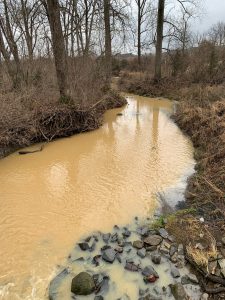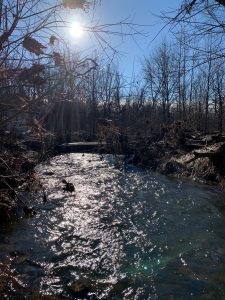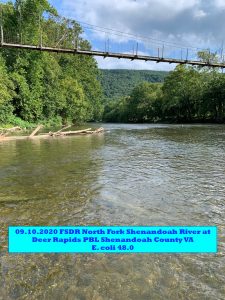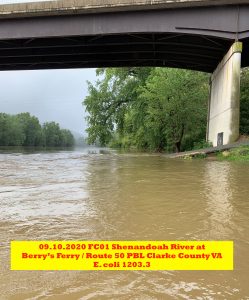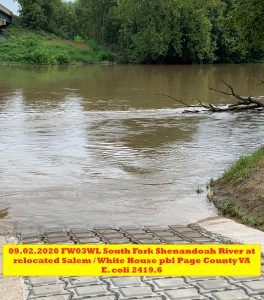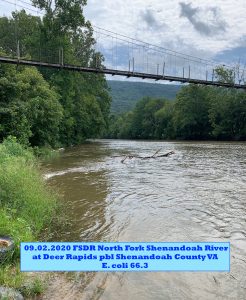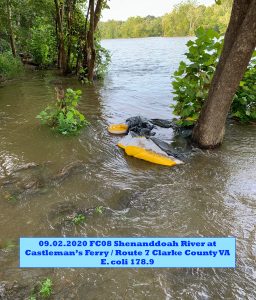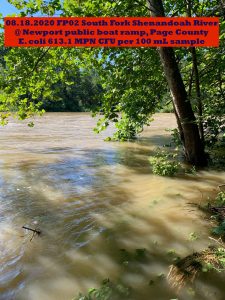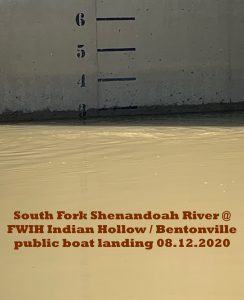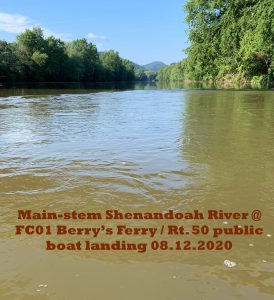Archive for the ‘Featured’ Category
Crucial public awareness and comment opportunity on the water-quality assessment methods used by DEQ for Virginia’s waters
Only with your support
This past year has seen a monumental increase in the use of public natural areas. The community has come to rely on the weekly E. coli concentration results updates from FOSR’s annual summer E. coli testing program at public access and recreational sites on the Shenandoah River. The goal of this program is to provide frequent, real-time accredited E. coli concentration results for river recreation users to make an informed decision about potential associated health risks when recreating in the areas of the river tested. The weekly quantitative E. coli concentration results are available to the public on both the FOSR website and Facebook page. The public’s interest in this program has been overwhelmingly positive. As a reminder of potential health risks when recreating in high flow, muddy, and/or turbid waters, the FOSR coined the slogan, “When it’s Brown, Turn Around”. Many times, when out collecting the water samples, FOSR staff is greeted with river goers calling out, “When it’s Brown, Turn Around”
Only with your support can the Friends of the Shenandoah River continue to provide this vital service. Please support us by making a donation today. https://fosr.org/join-us/join/
Friends of the Shenandoah River 1460 University Drive Winchester, VA 22601
FOSR’s 2020 Summer E. coli Results through 09.24.2020
Sorry about not posting the E. coli results for the water samples that were collected last week on Thursday, September 17, in a timely manner. We had technology difficulty which required the purchase of a new computer. This pdf file contains the E. coli concentration results for the water samples collected on Thursday, September 17, and yesterday, Thursday, September 24. Contact recreational use of the river is quieting down as the water temperatures are dropping and the sunsets are earlier.
FOSR 2020 Summer Quantitative E. coli Concentration Results through 09.24.2020
Raging waters of the Opequon Creek
On Thursday, September 10, 2020, the Opequon Creek was raging carrying with it tree trunks, branches, garbage, silt, sediment, and high levels of bacteria 💩.. (>2419.6 MPN CFUs E. coli bacteria per 100 mL of water sample.) The Opequon Creek was halfway up the access road to the water-quality monitoring site.
FOSR 2020 Summer Quantitative E. coli Concentration Results through 09.10.2020
FOSR’s 2020 Summer E. coli Results through 09.10.2020
“IF IT’S BROWN TURN AROUND”.
Depending on where you were in the Shenandoah River watershed yesterday, Thursday, September 10, 2020, the E. coli levels varied greatly. The two pictures below illustrate the contrasting differences in E. coli concentrations at different sites.
Previously in Virginia, if a single freshwater grab sample contained E. coli bacteria levels that exceeded 235 CFUs then the water would have been considered unsafe for primary recreational contact. Under the current Virginia Code for both the State Water Control Board and VA Dept. of Health, there is no longer any agency responsible to inform the public of potential exposure to elevated E. coli levels in the freshwater streams and rivers in Virginia! These are the E. coli results for the water samples collected yesterday, Wednesday, September 02, 2020.
FOSR 2020 Summer Quantitative E. coli Concentration Results through 09.10.2020
FOSR’s 2020 Summer E. coli Results through 09.02.2020
“IF IT’S BROWN TURN AROUND”.
Yesterday, Wednesday, September 02, 2020, the South Fork of the Shenandoah River was transporting silt, sediment, debris, garbage, logs, and high levels of bacteria. After the North Fork and South Fork combined making the Main-stem of the Shenandoah River, the lower bacteria levels and less turbid waters in the North Fork helped to dilute the bacteria levels coming from the South Fork.
Previously in Virginia, if a single freshwater grab sample contained E. coli bacteria levels that exceeded 235 CFUs then the water would have been considered unsafe for primary recreational contact. Under the current Virginia Code for both the State Water Control Board and VA Dept. of Health, there is no longer any agency responsible to inform the public of potential exposure to elevated E. coli levels in the freshwater streams and rivers in Virginia! These are the E. coli results for the water samples collected yesterday, Wednesday, September 02, 2020.
FOSR 2020 Summer Quantitative E. coli Concentration Results through 09.02.2020
FOSR’s 2020 Summer E. coli Results through 08.25.2020
Measurable rain events have been occurring in the southern region of the Shenandoah River watershed, which includes the North River, South River, and Middle River that are the headwaters of the South Fork of the Shenandoah River. One of the effects of these storms has been elevated E. coli levels in the South Fork and Main-stem of the Shenandoah.
These are the E. coli results for the water samples that were collected yesterday, Tuesday, August 25, 2020.
FOSR 2020 Summer Quantitative E. coli Concentration Results through 08.25.2020
River height and E. coli concentrations at site FWIH, South Fork of the Shenandoah River at the Bentonville public boat ramp off Indian Hollow Road

When its brown, turn around!
The effect of the rains from the southern region of the watershed is traveling downstream. Yesterday, the South Fork and Main-stem of the Shenandoah River was still running high and muddy/discolored. The E. coli levels at all five of the sites tested on the South Fork and the five sites tested on the Main-stem, including Manassas Run, exceeded the previous instantaneous Virginia water quality standard threshold of 235 E. Coli CFUs per 100ml of sample for primary recreational contact.
FOSR 2020 Summer Quantitative E. coli Concentration Results through 08.18.2020
FOSR’s 2020 Summer E. coli Results through 08.12.2020
These are the E. coli results for the water samples that were collected yesterday, Wednesday, August 12, 2020.
FOSR 2020 Summer Quantitative E. coli Concentration Results through 08.12.2020
At the following sites the E. Coli level exceeded the previous instantaneous Virginia water quality standard threshold of 235 E. Coli CFUs per 100ml of sample for primary recreational contact:
- FW36, Manassas Run upstream of the confluence with the Shenandoah River at Morgan Ford low water bridge in Warren County 1119.9 MPN E. coli CFU per 100mL/sample
The effect of the heavy rains that occurred in Augusta and Rockingham counties last week can still be seen in the South Fork in Luray and Warren Counties and the Main-stem of the Shenandoah River in Clarke County and beyond.

